After the release of the Core Ultra 200 processors, it became clear that it was too early to write off Raptor Lake. So far we have only seen the senior representatives of the new family in action, but from their performance it is not difficult to assume that the time-tested Core processors of the 13th and 14th generations will remain the preferred choice for gamers, especially now that, with the departure from the first roles and loss of flagship status, they will inevitably become cheaper. Compared to the latest Arrow Lake processors, Raptor Lake has two important advantages. Firstly, their P-cores operate at a higher clock frequency, and this applies not only to older models. And secondly, when working with memory, they demonstrate much lower latency, which is due to their monolithic single-chip design. It is these factors that provide them with better gaming performance, despite the microarchitecture improvements made in Arrow Lake.
For us, this means that it is clearly premature to abandon testing motherboards for LGA1700 – they will certainly remain the object of attention of many buyers, especially in the middle and lower price segments, for which AMD does not have modern processors enhanced with 3D cache. This is largely the reason why this review appeared. In it we will talk about the MSI B760 Gaming Plus WiFi motherboard, which is perfect for building a not too expensive, but peppy gaming computer based on Raptor Lake family processors. This board is no longer new, but this, as follows from everything said above, does not negate its relevance.
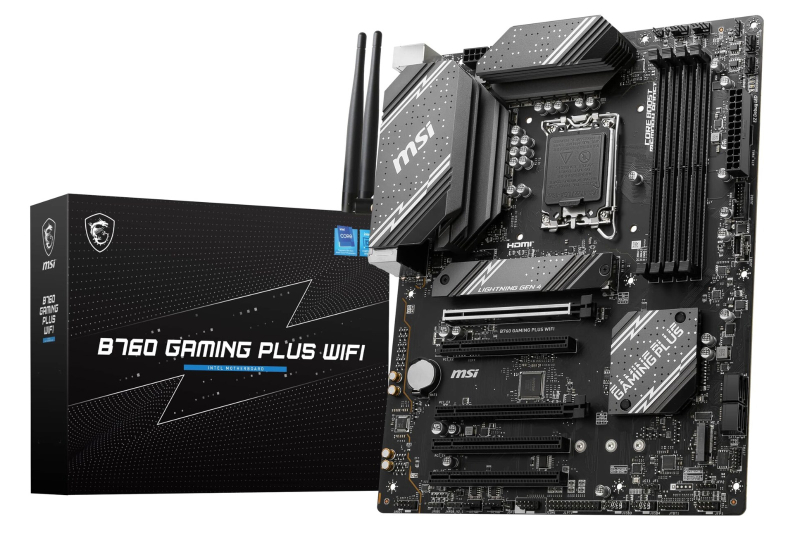
MSI Gaming Plus series motherboards rarely become the main characters of reviews, since they are not among the luxury flagships. This series ranks fourth in the MSI hierarchy – below MEG boards for uncompromising overclockers, MPG boards for wealthy gamers and mid-range MAG gaming boards. In fact, Gaming Plus is the lower level of gaming boards, but it is still not the most budget option, because for very undemanding users, MSI has a Pro Series.
MSI is renowned for its ability to create motherboards that offer value for money and features, and the Gaming Plus boards reflect this perfectly. They may not have fancy multi-phase power circuits, overclocking features, or playful backlighting, but they still have a sufficient range of capabilities for assembling a high-quality modern PC. Moreover, we are talking not only about the most basic things: such boards can offer a 2.5 Gbit/s network controller, a Wi-Fi 6E adapter, and radiators on M.2 slots. The Gaming Plus series even includes fully functional motherboards based on the flagship Z790 chipset, but in this review we will talk about a more affordable LGA1700 board based on the B760, which can be purchased for about 17 thousand rubles.
⇡#Specifications and scope of delivery
Anyone thinking about purchasing a more affordable board based on the B760 chipset rather than the older Z790 should be aware of what they will have to sacrifice. There are two main differences between these platforms. Firstly, the low-end chipset does not support overclocking the processor (memory can also be overclocked on B760 boards), and secondly, it has fewer supported PCIe lanes and USB ports. Therefore, the characteristics of B760 boards need to be carefully studied for expansion possibilities – they may simply not be enough. For example, today’s heroine, MSI B760 Gaming Plus WiFi, has only two M.2 slots, quite a few high-speed USB 3.2 ports, and no USB 3.2 Gen 2×2 ports at all.
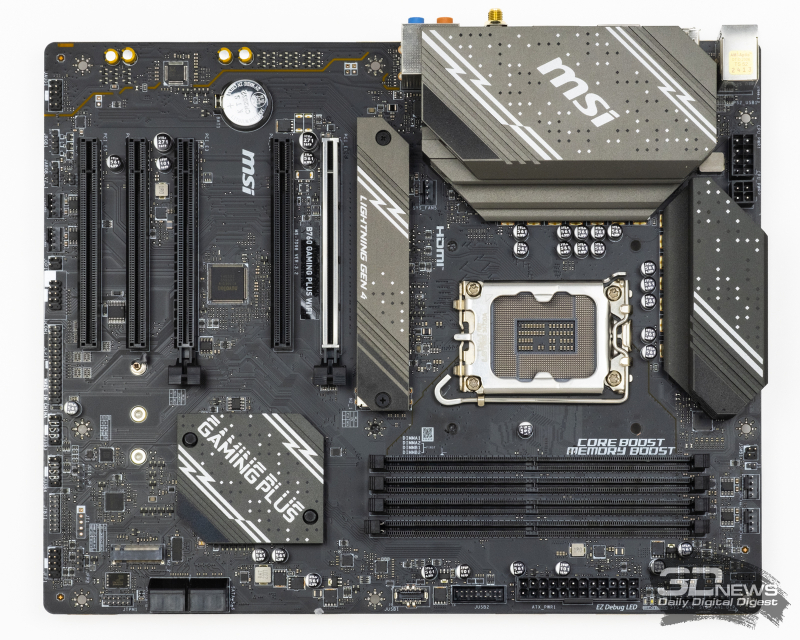
Another important point that needs to be mentioned at the beginning is memory support. B760-based boards are often made with DDR4 memory, but the B760 Gaming Plus WiFi is not like that. It is aimed at advanced and modern configurations, therefore it is equipped with slots for faster DDR5.
As a result, by the standards of B760 boards, the B760 Gaming Plus WiFi capabilities look pretty good, but Z790 boards, as a rule, offer richer functionality.
1 × PCI Express x4 4.0
1 × M.2 (2242/2260/2280) with support for PCI Express x4 4.0 and SATA 6 Gb/s
1 × RGB LED
2 × ARGB LED
1 × F-Audio
2 × USB 2.0
2 × USB 3.2 Gen 1 Type A
1 × USB 3.2 Gen 1 Type C
1 × Printer
1 × USB 3.2 Gen2 Type C
4 × USB 2.0
1 × PS/2
1 × RJ-45
1 × DisplayPort
1 × HDMI
1 × S/PDIF Out
5 x 3.5 mm audio
Indeed, if you compare this board with the Z790 Gaming Plus WiFi, which is formally similar in name, it turns out that the B760 Gaming Plus WiFi lacked a lot of things. Her memory support is worse; half the number of M.2 slots; there are only four SATA ports, not six, and there are only three USB 3.2 ports on the rear panel. However, it’s easy to turn a blind eye to all this thanks to the fact that the B760 Gaming Plus WiFi costs 6 thousand less.
It’s not at all surprising that the B760 Gaming Plus WiFi, as well as the Z790 Gaming Plus WiFi, are two very popular boards. They are among the top 10 best-selling motherboards on most of the world’s major online platforms, such as Amazon and Newegg. And this is another indicator that MSI in the Gaming Plus series has managed to achieve maximum compliance with the needs of the mass consumer.
Naturally, you shouldn’t expect anything special from the package of such an inexpensive board. Here, as in the specifications, this is just the required minimum. It includes a pair of Wi-Fi antennas, one SATA cable, a plug for the rear panel of the case, a stand for fixing an M.2 drive – and, in fact, that’s all. There is no media with drivers in the box with the board, so to connect the PC to the network for the first time, you may need another computer to download the driver.
⇡#Design and capabilities
The MSI B760 Gaming Plus WiFi is a full-size motherboard that looks quite convincing at first glance. It is clear that if you look closely at it, there will be a lot of places where the developers cut corners, but this is how it should be, because MSI tried to make an LGA1700 platform that, first of all, will be affordable. And most importantly, excessive savings did not affect cooling. The board is generously covered with heatsinks, especially in the area of the processor power circuit, and this gives hope that overheating of the power elements will bypass it, even if high-performance processors are used with it.
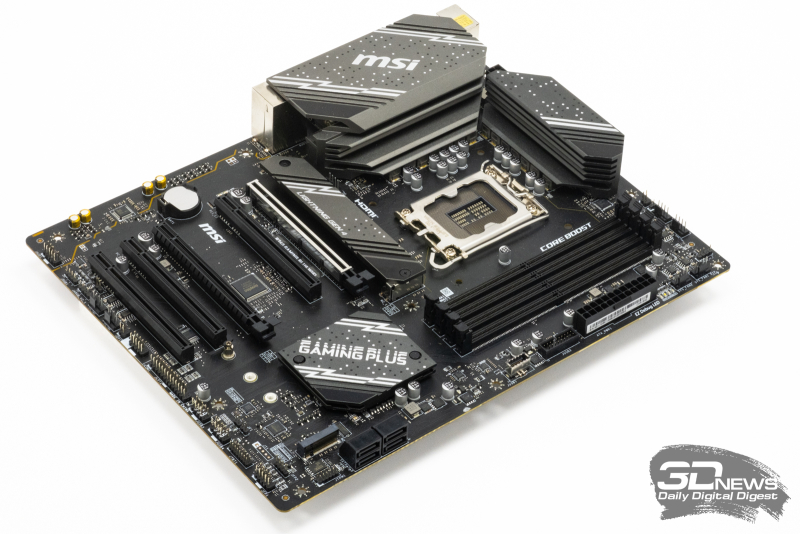
Indeed, the power converter is covered by two large aluminum radiators, and the rear radiator has an additional “cornice” covering the port area on top. This results in an increase in the surface area involved in heat dissipation.
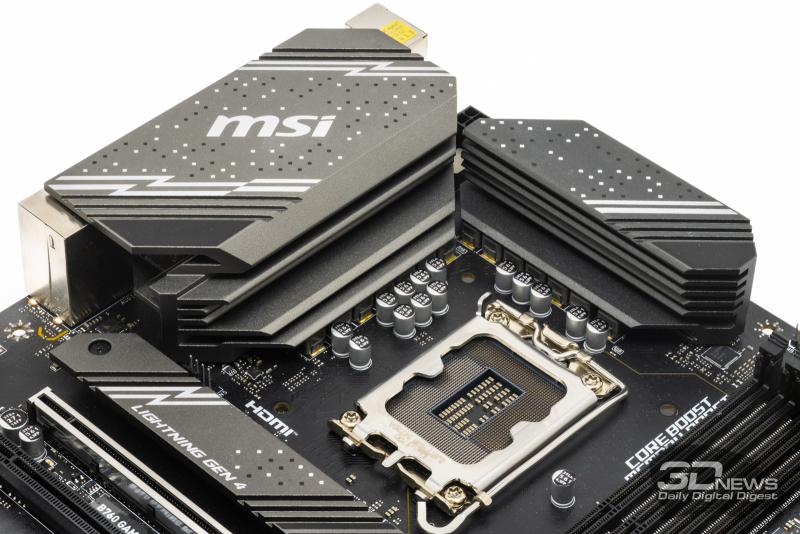
MSI also emphasizes that it has chosen a good thermal interface with a thermal conductivity of 7 W/(m∙K) for its radiators.
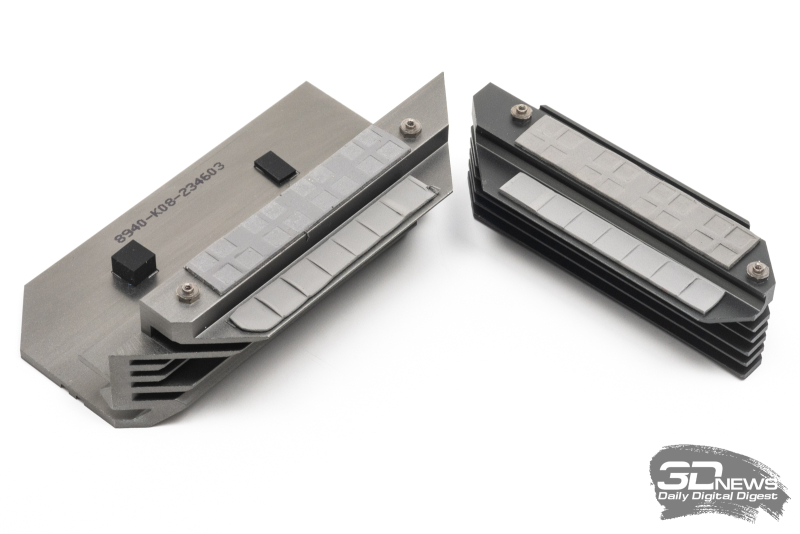
The power circuit hidden under the heatsinks doesn’t look too flimsy either. However, it only has six phases, which makes the B760 Gaming Plus WiFi a solution not at all for enthusiasts. However, MSI engineers tried to make sure that there was no lack of power – a double set of AONS36303 field-effect transistors, connected through doublers, is installed in each phase. The circuit is controlled by a Richtek RT3628AE PWM controller, which also allocates an additional phase to the graphics core. The peculiarity of this entire circuit is that its maximum capabilities strongly depend on temperature due to the properties of the transistors used. In a cold state, it can produce a peak current of up to 1000 A, but with a constant load and heating of the transistors to 100 degrees, this limit drops to 600 A. So massive radiators are partly a forced solution.
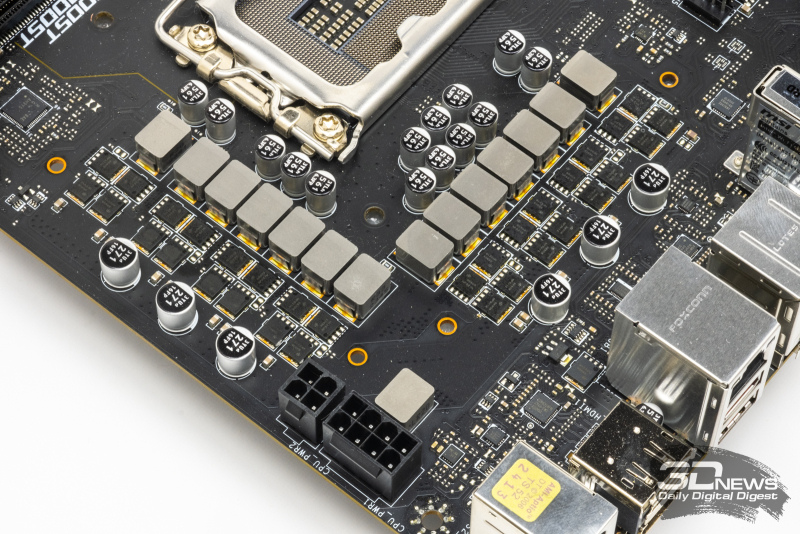
In any case, you need to understand that MSI Gaming Plus series motherboards are able to work stably with flagship processors only if consumption restrictions are set. This can be clearly seen from the fact that power is supplied to the VRM not by two 8-pin connectors, as on flagship boards, but by one 8-pin and one 4-pin.
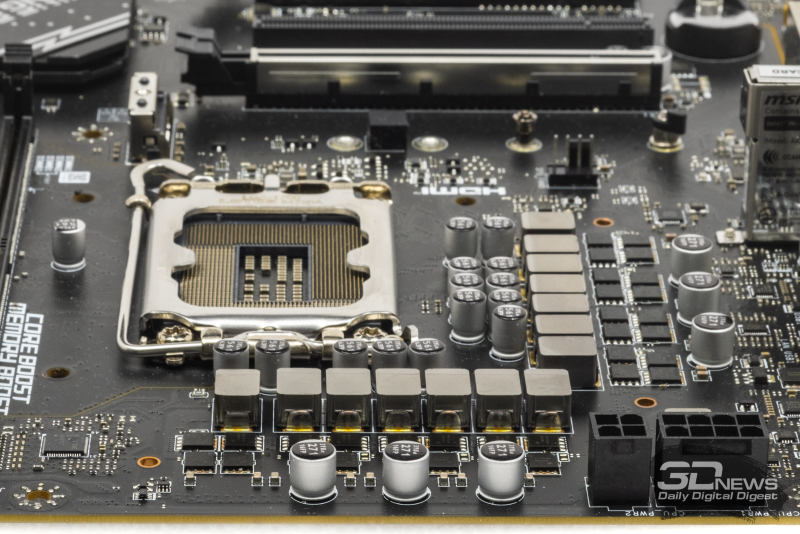
And here I would like to mention one interesting detail that few people pay attention to. The name of the MSI B760 Gaming Plus WiFi motherboard is not printed on the PCB, as is usually the case, but is written on a sticker glued to the board between the PCIe x16 slots.
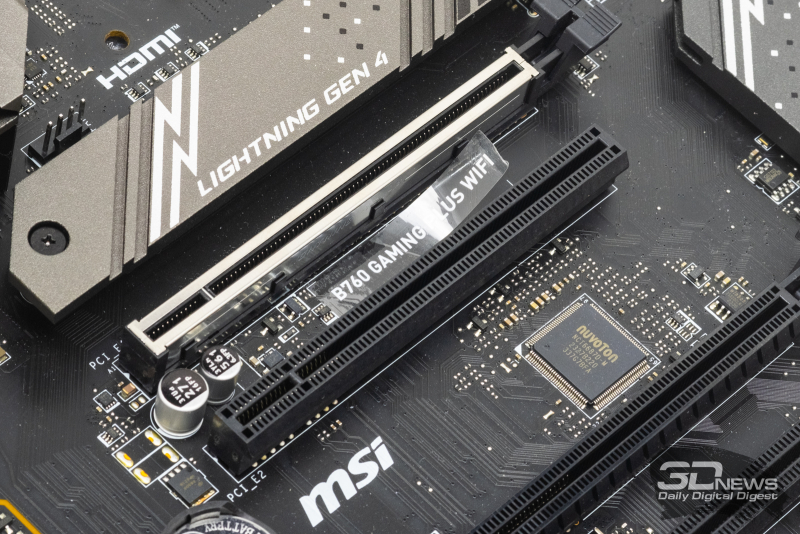
And do you know why? Due to unification: from a circuit design point of view, the B760 Gaming Plus WiFi is identical to most MSI ATX boards based on the B760 chipset belonging to the Pro Series, which are one step lower in the manufacturer’s hierarchy. This means that the same printed circuit board can become both a B760 Gaming Plus WiFi and some kind of Pro B760-VC WiFi. Therefore, there is no need to have any illusions about the motherboard in question – in fact, this is a budget solution, which was reinforced with a set of good radiators.
And this enhancement affected not only the cooling system on the VRM, but also the first M.2 slot, which on the B760 Gaming Plus WiFi also has its own heat dissipation plate.
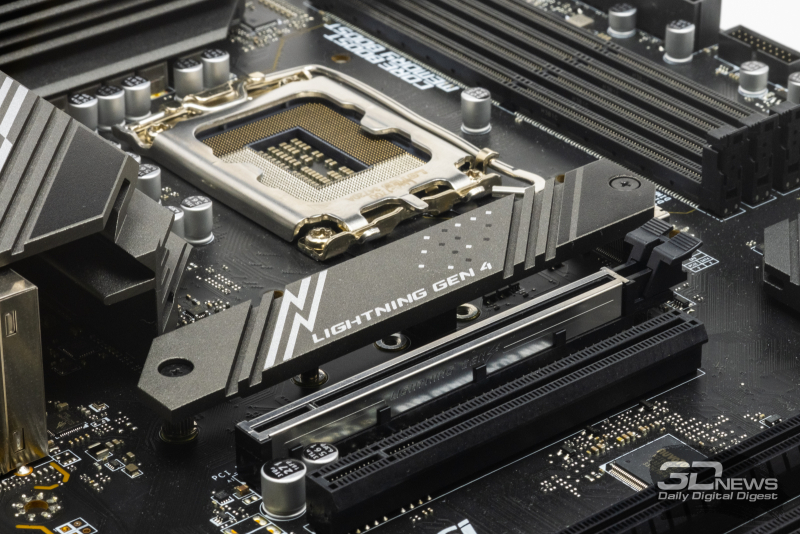
This slot is connected directly to the processor and supports PCIe 4.0 SSD. At the same time, the chipset is responsible for the operation of the second M.2 slot. It can also run PCIe 4.0 SSDs, but it no longer has its own heatsink. But you can install M.2 drives in it, including those with a SATA interface.
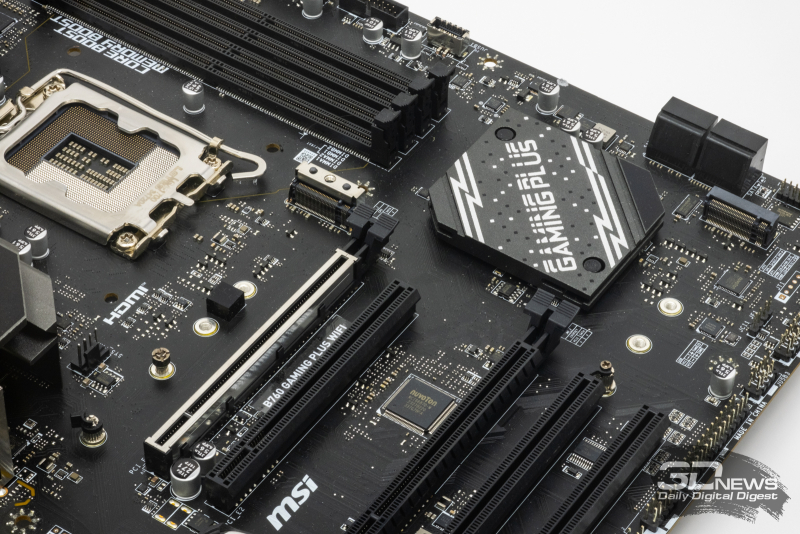
PCIe 4.0 support is limited to the B760 Gaming Plus WiFi and PCIe x16 graphics slot. Although LGA1700 processors are theoretically capable of working with video cards via the PCIe 5.0 x16 interface, MSI developers decided to save a little here too, by abandoning the redrivers required for this and careful balancing of signal lines. Therefore, PCIe 5.0 video cards, when they appear, will not work at full speed in this board.
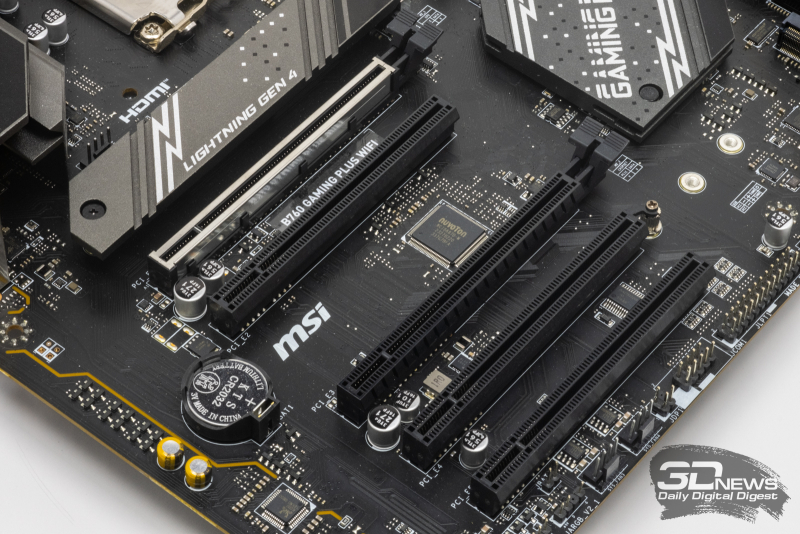
As a result, MSI engineers had the opportunity to reduce the cost of the textolite – it is six-layer in the B760 Gaming Plus WiFi. As a rule, this affects memory performance, which on such boards is rarely stable at high frequencies. Therefore, it is not surprising that for the B760 Gaming Plus WiFi the manufacturer talks about DDR5-6800 as the maximum achievable mode, even if you use high-quality overclocking modules on SK Hynix A-Die chips.
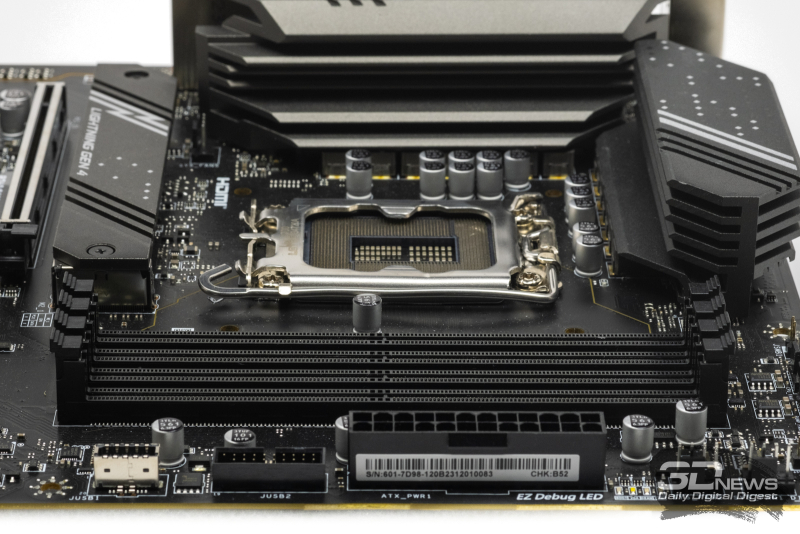
However, the listed compromises in the design of the B760 Gaming Plus WiFi concern only support for flagship hardware. If you do not use Core i9 processors, overclockable memory modules and high-end video cards, you may not even know about any restrictions imposed by this board. But what everyone will probably notice is the reduced number of USB ports on the rear panel. There are only three USB 3.2 Gen 2 (10 Gbps) ports (two Type A and one Type C); There is no USB 3.2 Gen 2×2 (20 Gbps) at all; and the remaining four ports are slow USB 2.0. Moreover, additional USB 3.2 Gen 2 ports cannot be placed on the front panel of the case – the internal connectors on the board only support USB 3.2 Gen 1 (5 Gbps).
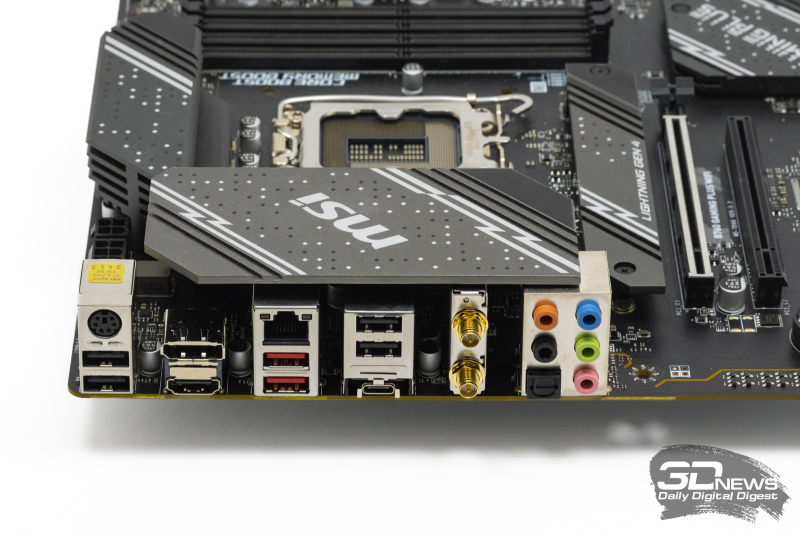
The integrated sound on the MSI B760 Gaming Plus WiFi is provided by an eight-channel Realtek ALC897 codec, which is quite simple in modern times. The five 3.5 mm audio jacks and SPDIF output it serves are located on the rear panel of the board. The entire audio path is assembled according to a standard design – with electrical separation from the rest of the board and using Chemicon audio capacitors.
At the same time, in terms of network capabilities, the MSI B760 Gaming Plus WiFi is done to the highest standard. The RJ-45 network port located on the rear panel is implemented by the Realtek RTL8125BG controller and supports 2.5 Gbit/s connections. The wireless network adapter used is Intel AX211 Wi-Fi 6E standard, which is capable of providing connection speeds of up to 2.4 Gbps (in ideal conditions). Two RP-SMA antenna connectors from this adapter are located on the rear panel of the board; the necessary antennas are included in the package.
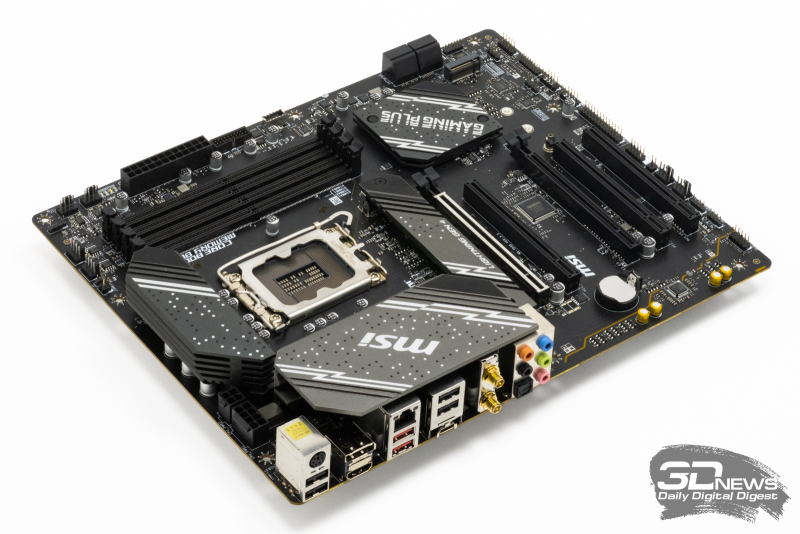
Since the MSI B760 Gaming Plus WiFi is an inexpensive board, it has a rather ordinary appearance in black and gray. Naturally, there is no LED backlight on it, except for the four diagnostic LEDs that light up during system startup. However, the board does not deprive users of the opportunity to illuminate the insides of the PC with additional RGB strips. It provides one connector for regular 12V RGB strips with a power of up to 36 W and two connectors for addressable strips with a voltage of 5 V and a power of up to 15 W.
More details about the location of these and other connectors on the board can be found in the layout diagram.
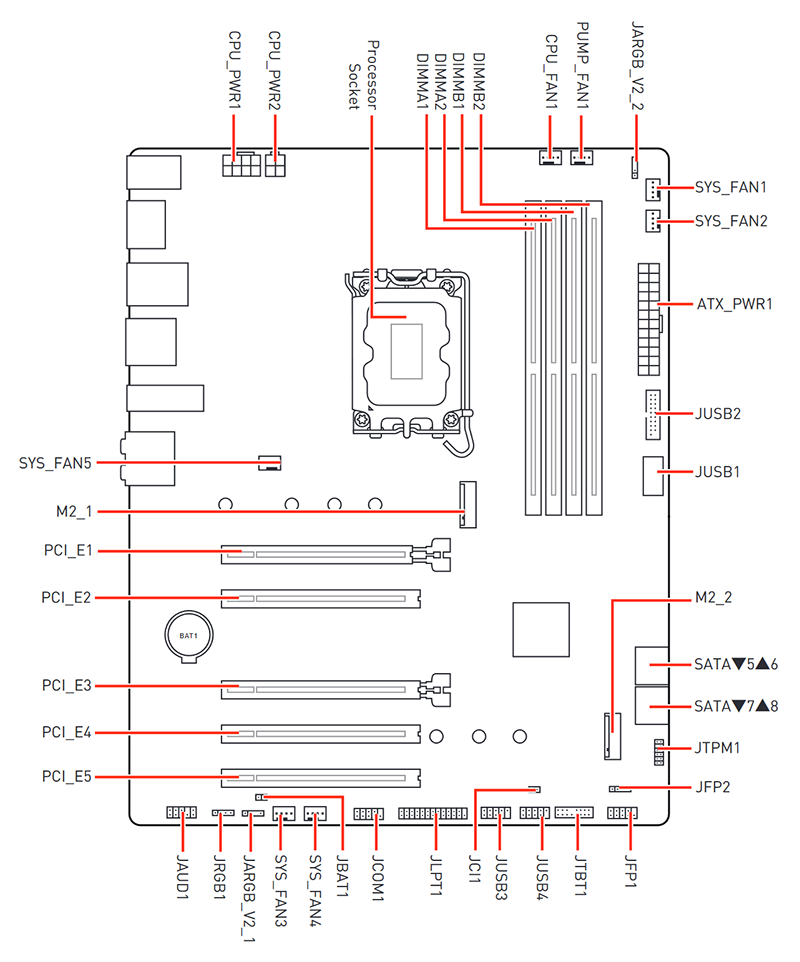
It’s hard to make any claims about the set of fan connectors. There are seven of them in total: a processor one, one for the liquid-liquid system pump, and five case-based ones. All of them allow you to regulate fan speed both through voltage and through PWM, but there is a fundamental difference in their power. The connector for the LSS pumps pulls 36-W devices, the processor – 24-W, and all the others – only 12-W.
⇡#Test system
Testing of the MSI B760 Gaming Plus WiFi was carried out in a system composed of the following set of components:
-
- Intel Core i7-14700K (Raptor Lake Refresh, 8P+12E-core, 3.4-5.6/2.5-4.3 GHz, 33 MB L3);
- Intel Core i5-14600K (Raptor Lake Refresh, 6P+8E cores, 3.5-5.3/2.6-4.0 GHz, 24 MB L3);
- Intel Core i5-14400F (Alder Lake, 6P+4E cores, 2.5-4.7/1.8-3.5 GHz, 20 MB L3).
- CPU cooler: custom liquid cooling system made from EKWB components.
- Motherboard: MSI B760 Gaming Plus WiFi (LGA1700, Intel B760).
- Memory: 2 × 16 GB DDR5-7600 SDRAM, 36-46-46-121 (G.Skill Trident Z5 F5-7600J3646G16GX2-TZ5RK).
- Video card: GIGABYTE GeForce RTX 4090 Gaming OC (AD102 2235/2535 MHz, 24 GB GDDR6X 21 Gbps).
- Disk subsystem: Intel SSD 760p 2 TB (SSDPEKKW020T8X1).
- Power supply: ASUS ROG-THOR-1200P (80 Plus Titanium, 1200 W).
Testing was performed on the Microsoft Windows 11 Pro (23H2) Build 22631.4112 operating system using the following set of drivers:
- Intel Chipset Driver 10.1.19913.8607;
- NVIDIA GeForce 560.94 Driver.
MSI B760 Gaming Plus WiFi tested with BIOS version E7D98IMS.HA0 dated October 15, 2024.
⇡#BIOS
The B760 Gaming Plus WiFi uses the Click BIOS 5 shell, which is unlikely to surprise anyone, since MSI has been using all its boards for several years. Many people criticize this shell for its inconvenience and illogical organization, and in new motherboards MSI has already replaced it with a newer Click BIOS X interface, but the B760 Gaming Plus WiFi being reviewed today is not affected by all this. However, we can’t blame the BIOS of this board for not having enough settings – the vast majority of the options that we are used to seeing on expensive LGA1700 boards are also available on the B760 Gaming Plus WiFi.
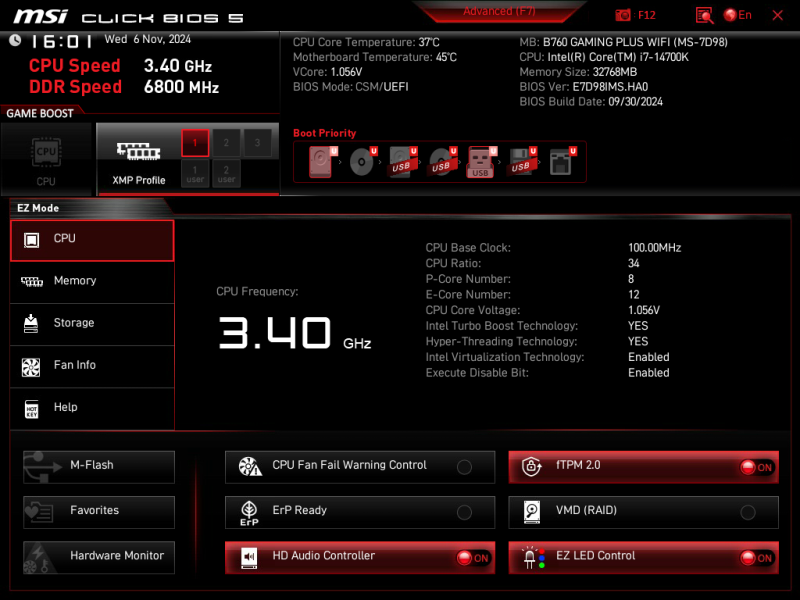
When entering the BIOS, the user is greeted with a simplified interface through which you can get basic information about installed components, set the order in which boot devices are polled, enable XMP profiles for memory, configure fans, or update the firmware. However, MSI’s proprietary Game Boost function for automatically overclocking the processor is not available in this case – the company allows its use only on higher-level boards.
Switching to the “advanced” BIOS mode provides access to a full set of settings. Processor and memory parameters that directly affect performance are collected in a special section of the OS. But in this case, their set is not so extensive due to the fact that the board in question is based on the mid-level B760 chipset, in which CPU overclocking is blocked by Intel.
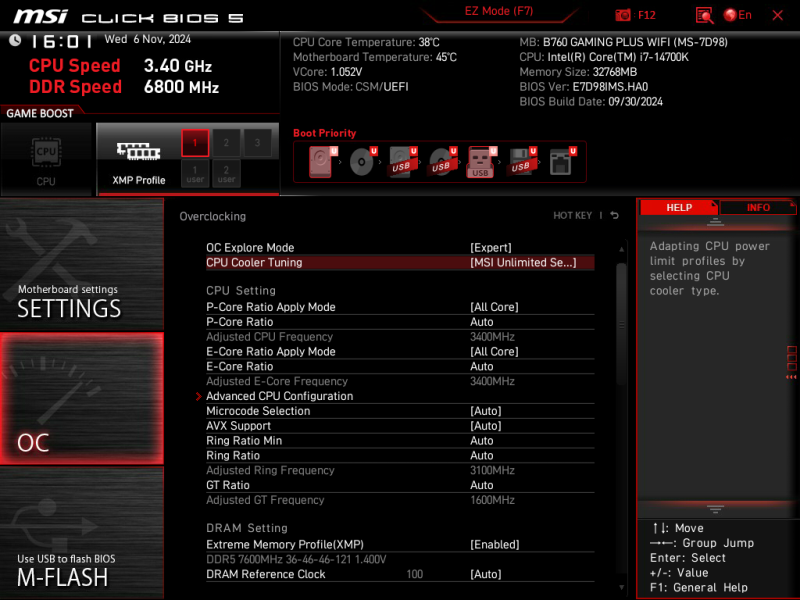
For the processor, it is possible to change the supply voltage (via offset), the Loadline Calibration function, as well as limiting consumption and maximum temperature. By the way, upon first startup, the board proactively offers to limit the limits of PL1 and PL2 itself – based on the cooling system used. It is curious that in the maximum settings – for life support systems – the board sets consumption limits at 253 W, although, as it became clear in practical testing, its power converter is not able to handle such a load.
It is important that MSI has implemented a set of functions for processor downvolting in the B760 Gaming Plus WiFi. An option has been added to the BIOS to disable IA CEP (Current Excursion Protection) for Raptor Lake, which allows you to reduce the supply voltage of these processors without losing performance. In addition to this, the BIOS has an option to rollback the processor microcode to 0x105, which in some cases also helps in maintaining the original CPU performance when running at reduced voltage.
As for DDR5 memory, you can change voltages, operating frequencies and timings (both primary and secondary-tertiary). In addition to the ability to configure delays completely manually or automatically via XMP, the board also offers ready-made profiles of optimized timing schemes for various frequencies of DDR5 modules (Memory Try It!) function.
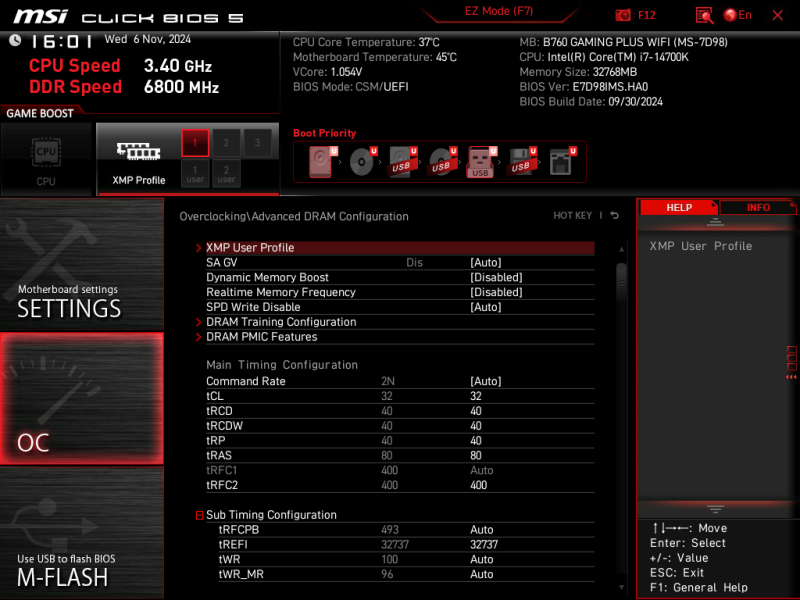
If we put together all the voltages available for changing in the BIOS, we get the following list.
The set is not too large, but you need to understand that the B760 Gaming Plus WiFi is a board not intended for overclocking. However, it will allow you to make the most important settings for the LGA1700 system, such as a slight downvolt of the processor and optimizing DDR5 SDRAM timings, without any problems.
Separately, it should be noted that the BIOS of the B760 Gaming Plus WiFi has rich options for configuring fans. For each of them, you can determine your own dependence of the rotation speed on the temperature of any of the sensors (processor, board, chipset, VRM), and fans with both three-pin and four-pin connections are supported.
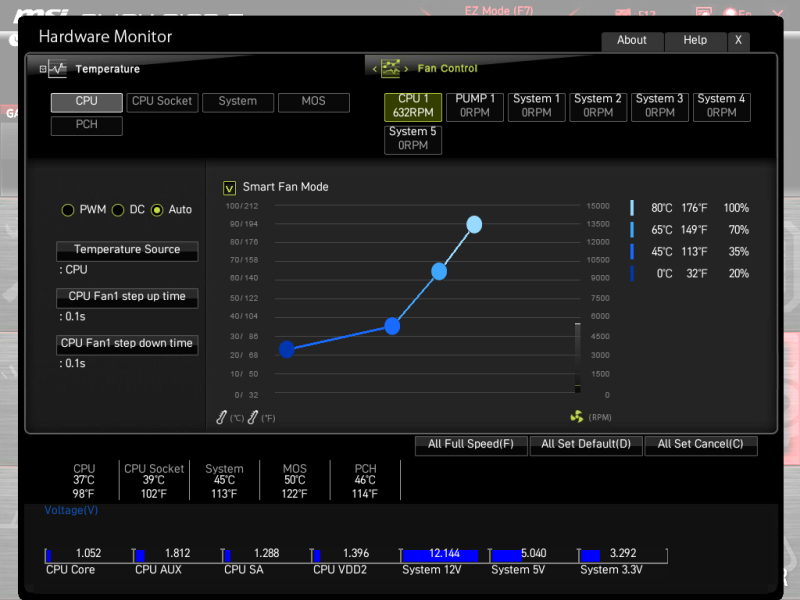
You can thoroughly study how the BIOS of the MSI B760 Gaming Plus WiFi is organized and what settings it offers using the gallery of screenshots.
⇡#Testing
The main question that arises regarding motherboards of the MSI B760 Gaming Plus WiFi level is which processors are “suitable” for them and which are “too much.” The power supply system of this motherboard looks pretty good, but is still much inferior to the circuits used on expensive boards. Therefore, we decided to test everything in practice. The procedure for this test is simple – the board should be able to handle half an hour of rendering in Cinebench R23 without overheating the VRM.
Let’s start with something simple. At the first stage, the MSI B760 Gaming Plus WiFi was equipped with a Core i5-14400 processor, which has six productive cores and four energy-efficient ones. The core frequencies of this processor at full load in Cinebench R23 are 4.1 and 3.5 GHz, respectively, consumption is about 90 W. And such a processor does not create any difficulties for the board in question. In half an hour, her diet reaches a temperature of only 60 degrees.
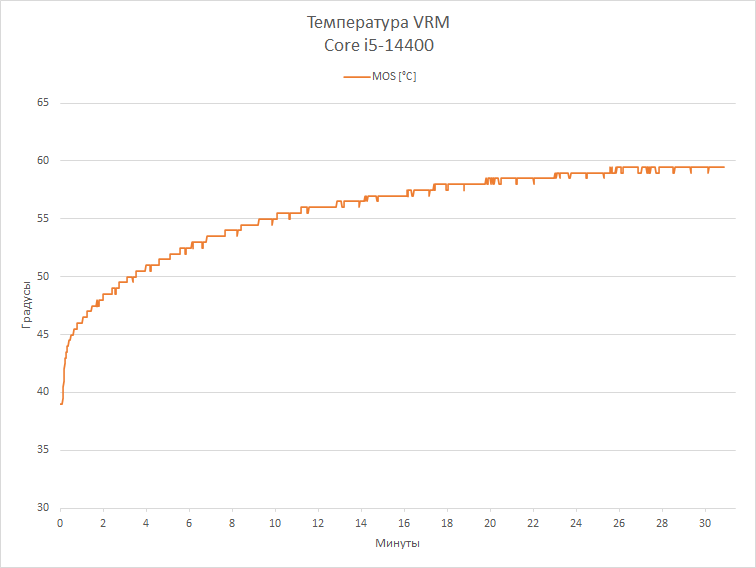
The external temperature of the radiators, judging by the thermogram, in this case is about 50 degrees, and the textolite in the vicinity of the processor socket is only a few degrees warmer. All this says one thing – the board in question works fine with the lower-end Core i5.
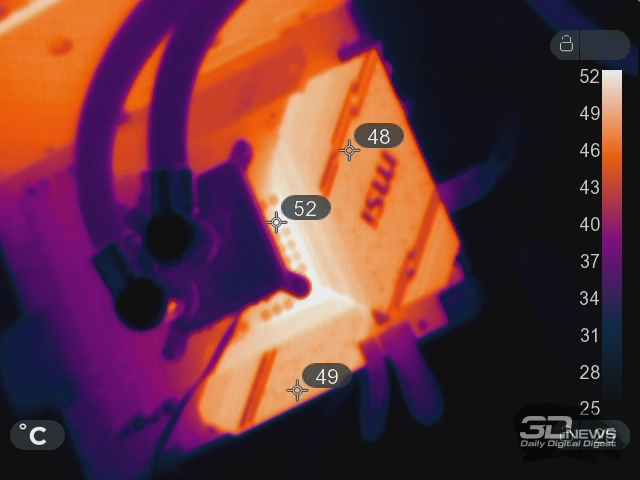
The second stage of testing is a little more complex – in it the board was equipped with a Core i5-14600K processor. This CPU has six productive and eight efficient cores plus noticeably higher frequencies. Under load, they reach 5.3 and 4 GHz on both types of cores, respectively. And such a processor requires about 210 W of electricity to operate in Cinebench R23. Providing the necessary currents for the MSI B760 Gaming Plus WiFi power converter in this case becomes not such an easy task. The heating of the power circuit after half an hour of load reaches 97 degrees, which looks like a borderline mode, although formally the transistors included in the power circuit have an operating temperature range of up to 150 degrees.
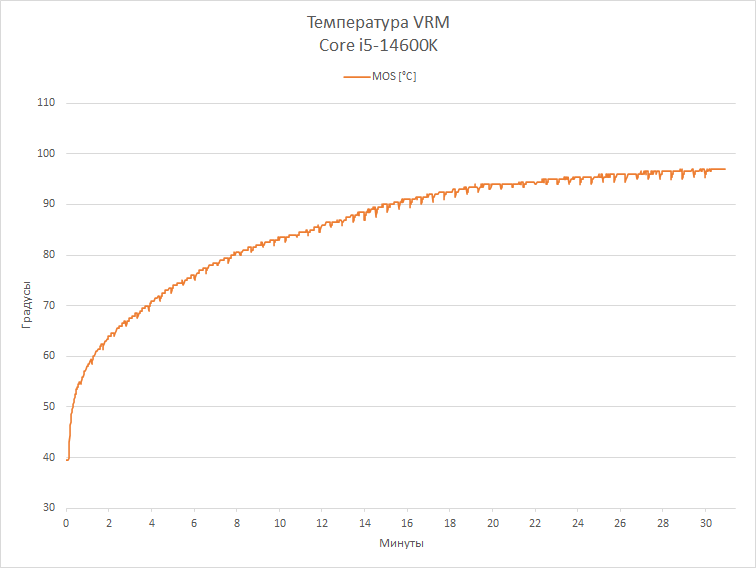
The heatsinks of the power circuit reach a temperature of 70-75 degrees, the PCB around LGA1700 heats up to 82 degrees. In general, this mode of operation of the board can be succinctly characterized by the words of the classic: “Doubtful, but okay.” If necessary, the board is capable of working with a Core i5-14600K, although you will probably have to think about some kind of enhanced airflow for the VRM area.
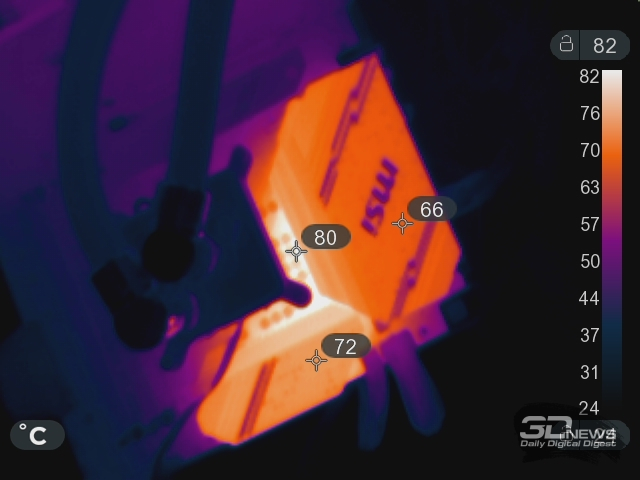
At the third stage, an even more powerful CPU was installed on the board – Core i7-14700K. It has a core formula of 8P+12E and at full load on all 28 threads it runs on MSI B760 Gaming Plus WiFi with a frequency of 5 GHz on P-cores and 4 GHz on E-cores. The processor consumption in this case is about 210-220 W, and all these numbers indicate that the board with the Core i7-14700K can no longer cope and artificially limits its performance. Because on higher-end motherboards this processor keeps the P-core frequency at 5.2 GHz and the E-core at 4.3 GHz.
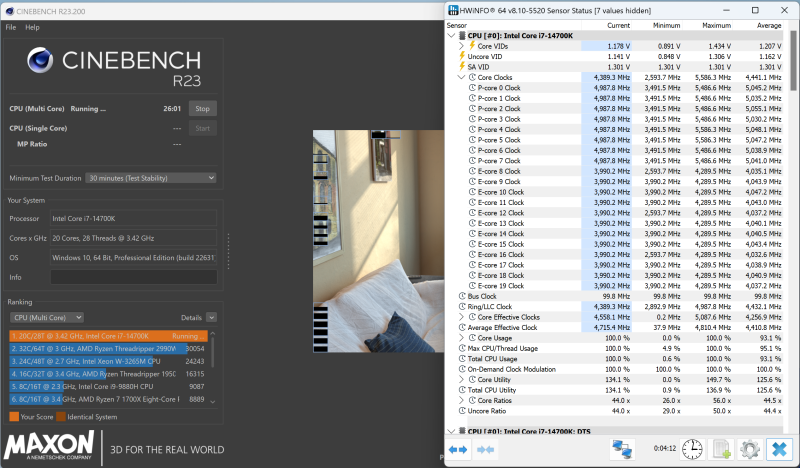
You can confirm that the Core i7-14700K is pushing the MSI B760 Gaming Plus WiFi beyond its capabilities by looking at the VRM heating graph during the Cinebench R23 test – the temperature quickly exceeds the 100-degree limit.
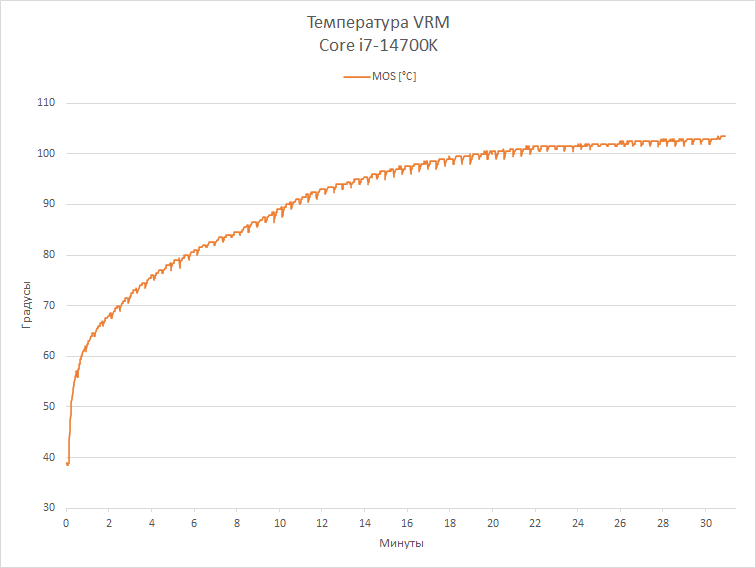
The thermal image of the VRM zone shows heating of the radiators up to 80 degrees and the PCB around the processor socket above 90 degrees. It is highly not recommended to operate the board in this mode – with such heating, it can quickly fail due to degradation or damage to the power circuit. In other words, the Core i5-14600K for the MSI B760 Gaming Plus WiFi is a reasonable maximum.
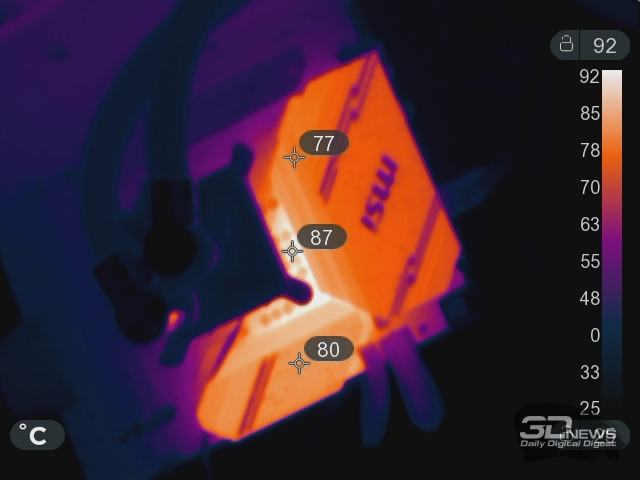
The MSI B760 Gaming Plus WiFi also imposes certain restrictions on memory speed. Its specifications, as well as the compatibility list, indicate the maximum frequency of DDR5 modules at 6800 MHz. And this corresponds to what this board can do in reality. With memory at a higher frequency, it starts and loads the OS, but it is no longer possible to achieve complete stability. Therefore, there is no point in taking specialized DDR5-7200/7600 overclocking modules for the B760 Gaming Plus WiFi – they still won’t work at full capacity. But memory of the DDR5-6000/6400 class is suitable for this board without question, and it can be overclocked by one or two steps.
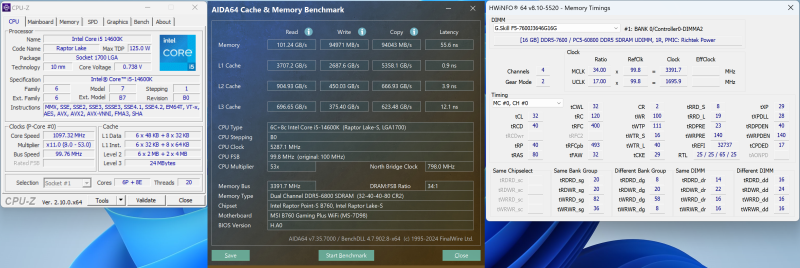
Thus, in the tests, the MSI B760 Gaming Plus WiFi showed itself to be a typical inexpensive mid-level board, and you should build a system based on it, choosing mid-range hardware. It will not be able to digest flagship components. And this, by the way, clearly shows how expensive motherboards differ from cheap ones. The point here is not only in the number of ports and the wealth of settings in the BIOS, but also in compatibility with advanced hardware.
⇡#Conclusions
The MSI B760 Gaming Plus WiFi comes in a price range where you don’t expect too much. But although this is a very affordable board for LGA1700 processors, oddly enough, it does not look like a “poor relative”. For example, it has functions typical of higher-level solutions, such as support for a wired 2.5 Gbps network and wireless Wi-Fi 6E. The “unexpected” advantages of the B760 Gaming Plus WiFi include a full-size form factor, five PCIe x16 slots, and high-quality heatsinks on the processor power circuit and the first M.2 slot. And also – support for seven fans, thoughtful design and neat appearance.
All this makes the MSI B760 Gaming Plus WiFi board perfect for building that type of modern mid-range gaming PC that is usually described with the addition of the phrase “reasonably priced”. In fact, this is one of the most affordable ATX boards for LGA1700 processors with Wi-Fi support, and this is one of its main advantages. Therefore, the fact that it has won a place among the most popular LGA1700 motherboards in retail sales is not at all surprising.
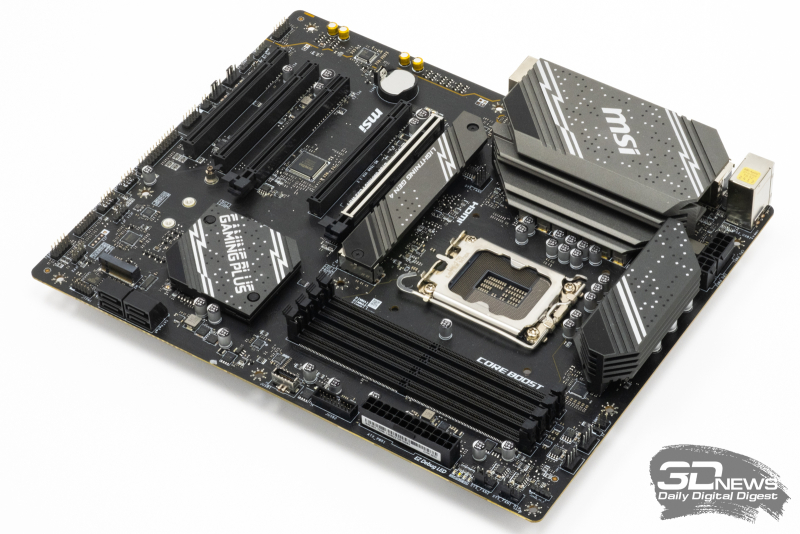
However, it cannot be said that the B760 Gaming Plus WiFi has avoided compromises. Testing has shown that it may have difficulty working with high-performance processors that consume more than 200 W. Representatives of the Core i3 and Core i5 series are a reasonable choice for it, and the use of CPUs of the Alder Lake and Raptor Lake generations with eight powerful cores in this board is not recommended. In addition, it is not very strong in memory overclocking, limiting itself to DDR5-6800 support. In other words, you shouldn’t assume that MSI managed to make a cheap motherboard without weak points.
But such flaws can only appear if the level of the motherboard and other components does not match, which happens quite rarely. Therefore, in most cases, real users of the B760 Gaming Plus WiFi simply will not notice the listed shortcomings, and the reviewed MSI board will prove to be an absolutely stable, predictable and convenient solution in their hands.